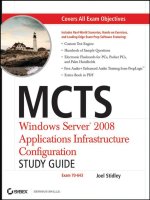Wiley IP multicast with applications to IPTV and mobile DVB h apr 2008 ISBN 0470258152 pdf
Bạn đang xem bản rút gọn của tài liệu. Xem và tải ngay bản đầy đủ của tài liệu tại đây (5.44 MB, 376 trang )
IP MULTICAST WITH
APPLICATIONS TO IPTV
AND MOBILE DVB-H
Daniel Minoli
A JOHN WILEY & SONS, INC., PUBLICATION
IP MULTICAST WITH
APPLICATIONS TO IPTV
AND MOBILE DVB-H
IP MULTICAST WITH
APPLICATIONS TO IPTV
AND MOBILE DVB-H
Daniel Minoli
A JOHN WILEY & SONS, INC., PUBLICATION
Copyright Ó 2008 by John Wiley & Sons, Inc. All rights reserved
Published by John Wiley & Sons, Inc.
Published simultaneously in Canada
No part of this publication may be reproduced, stored in a retrieval system, or transmitted in any form or by
any means, electronic, mechanical, photocopying, recording, scanning, or otherwise, except as permitted
under Section 107 or 108 of the 1976 United States Copyright Act, without either the prior written permission
of the Publisher, or authorization through payment of the appropriate per-copy fee to the Copyright Clearance
Center, Inc., 222 Rosewood Drive, Danvers, MA 01923, (978) 750-8400, fax (978) 750-4470, or on the web at
www.copyright.com. Requests to the Publisher for permission should be addressed to the Permissions
Department, John Wiley & Sons, Inc., 111 River Street, Hoboken, NJ 07030, (201) 748-6011, fax (201) 7486008, or online at />Limit of Liability/Disclaimer of Warranty: While the publisher and author have used their best efforts in
preparing this book, they make no representations or warranties with respect to the accuracy or completeness
of the contents of this book and specifically disclaim any implied warranties of merchantability or fitness for
a particular purpose. No warranty may be created or extended by sales representatives or written sales
materials. The advice and strategies contained herein may not be suitable for your situation. You should consult
with a professional where appropriate. Neither the publisher nor author shall be liable for any loss of profit or
any other commercial damages, including but not limited to special, incidental, consequential, or other
damages.
For general information on our other products and services or for technical support, please contact our
Customer Care Department within the United States at (800) 762-2974, outside the United States at (317) 5723993 or fax (317) 572-4002.
Wiley also publishes its books in a variety of electronic formats. Some content that appears in print may not be
available in electronic formats. For more information about Wiley products, visit our web site at www.wiley.com.
Library of Congress Cataloging-in-Publication Data
Minoli, Daniel, 1952IP multicast with applications to IPTV and mobile DVB-H / Daniel Minoli.
p. cm.
Includes bibliographical references and index.
ISBN 978-0-470-25815-6 (cloth)
1. Webcasting. 2. Internet television. 3. Digital video. I. Title.
TK5105.887M578 2008
006.7–dc22
2007038116
Printed in the United States of America
10 9 8 7 6 5 4 3 2 1
For Anna and the kids.
And for my parents Gino and Angela
Also thanking
Mike Neen
CONTENTS
Preface
xiii
About the Author
xv
1
2
3
INTRODUCTION TO IP MULTICAST
1.1 Introduction
1.2 Why Multicast Protocols are Wanted/Needed
1.3 Basic Multicast Protocols and Concepts
1.4 IPTV and DVB-H Applications
1.5 Course of Investigation
Appendix 1.A: Multicast IETF Request for Comments
Appendix 1.B: Multicast Bibliography
References
1
1
3
5
11
21
21
23
23
MULTICAST ADDRESSING FOR PAYLOAD
2.1 IP Multicast Addresses
2.1.1 Limited Scope Addresses
2.1.2 GLOP Addressing
2.1.3 Generic IPv4 Addressing
2.2 Layer 2 Multicast Addresses
2.2.1 Ethernet MAC Address Mapping
2.3 MPEG-Layer Addresses
References
26
26
29
30
30
31
31
33
38
MULTICAST PAYLOAD FORWARDING
3.1 Multicasting on a LAN Segment
3.2 Multicasting between Network Segments
3.3 Multicast Distribution Trees
3.4 Multicast Forwarding: Reverse Path Forwarding
3.5 Multicast Forwarding: Center-Based Tree Algorithm
3.6 Implementing IP Multicast in a Network
References
39
40
40
41
47
48
49
50
vii
viii
4
5
6
CONTENTS
DYNAMIC HOST REGISTRATION—INTERNET
GROUP MANAGEMENT PROTOCOL
4.1 IGMP Messages
4.2 IGMPv3 Messages
4.3 IGMP Operation
Appendix 4.A: Protocol Details for IGMPv2
4.A.1 Overview
4.A.2 Protocol Description
4.A.3 Receiver (Host) State Diagram
4.A.4 Router State Diagram
Appendix 4.B: IGMP Snooping Switches
Appendix 4.C: Example of Router Configurations
References
51
52
55
61
63
63
64
65
69
72
76
77
MULTICAST ROUTING—SPARSE-MODE PROTOCOLS:
PROTOCOL INDEPENDENT MULTICAST
5.1 Introduction to PIM
5.2 PIM SM Details
5.2.1 Approach
5.2.2 PIM SM Protocol Overview
5.2.3 Detailed Protocol Description
5.2.4 Packet Formats
References
78
79
83
86
86
94
114
124
MULTICAST ROUTING—SPARSE-MODE PROTOCOLS:
CORE-BASED TREES
6.1 Motivation
6.2 Basic Operation
6.3 CBT Components and Functions
6.3.1 CBT Control Message Retransmission Strategy
6.3.2 Nonmember Sending
6.4 Core Router Discovery
6.5 Protocol Specification Details
6.5.1 CBT HELLO Protocol
6.5.2 JOIN_REQUEST Processing
6.5.3 JOIN_ACK Processing
6.5.4 QUIT_NOTIFICATION Processing
6.5.5 ECHO_REQUEST Processing
6.5.6 ECHO_REPLY Processing
125
126
127
129
131
131
131
132
133
134
135
135
136
137
CONTENTS
6.5.7 FLUSH_TREE Processing
6.5.8 Nonmember Sending
6.5.9 Timers and Default Values
6.5.10 CBT Packet Formats and Message Types
6.5.11 Core Router Discovery
6.6 CBT Version 3
6.6.1 The First Step: Joining the Tree
6.6.2 Transient State
6.6.3 Getting ‘‘On Tree’’
6.6.4 Pruning and Prune State
6.6.5 The Forwarding Cache
6.6.6 Packet Forwarding
6.6.7 The ‘‘Keepalive’’ Protocol
6.6.8 Control Message Precedence
and Forwarding Criteria
6.6.9 Broadcast LANs
6.6.10 The ‘‘all-cbt-routers’’ Group
6.6.11 Nonmember Sending
References
7
8
ix
137
138
138
138
142
145
145
146
146
147
147
148
148
149
149
150
150
151
MULTICAST ROUTING—DENSE-MODE
PROTOCOLS: PIM DM
7.1 Overview
7.2 Basic PIM DM Behavior
7.3 Protocol Specification
7.3.1 PIM Protocol State
7.3.2 Data Packet Forwarding Rules
7.3.3 Hello Messages
7.3.4 PIM DM Prune, Join, and Graft Messages
7.3.5 State Refresh
7.3.6 PIM Assert Messages
7.3.7 PIM Packet Formats
References
152
152
153
155
156
158
159
160
170
175
182
184
OTHER DENSE-MODE MULTICAST ROUTING PROTOCOLS:
DVMRP AND MOSPF
8.1 Distance Vector Multicast Algorithm
8.1.1 Overview
8.1.2 Basic DVMRP Operation
185
185
185
186
x
CONTENTS
9
10
8.2 Multicast OSPF
References
190
193
IP MULTICASTING IN IPv6 ENVIRONMENTS
9.1 Opportunities Offered by IPv6
9.2 Introductory Overview of IPv6
9.2.1 IPv6 Benefits
9.2.2 Traditional Addressing Classes for IPv4
9.2.3 Network Address Translation Issues in IPv4
9.2.4 IPv6 Address Space
9.2.5 Basic Protocol Constructs
9.2.6 IPv6 Autoconfiguration
9.3 Migration and Coexistence
9.4 Multicast with IPv6
9.4.1 IPv6 Multicast Addresses
9.4.2 MAC Layer Addresses
9.4.3 Signaling
9.4.4 RP Approaches
References
194
194
196
197
198
199
200
201
204
208
211
211
211
213
213
213
MULTICAST LISTENER DISCOVERY
10.1 Overview of MLDv1
10.2 Message Format
10.3 Protocol Description
10.4 Node State Transition Diagram
10.5 Router State Transition Diagram
10.6 Overview of MLDv2
10.6.1 Protocol Overview
10.6.2 Building Multicast Listening State on Multicast
Address Listeners
10.6.3 Exchanging Messages between the Querier
and the Listening Nodes
10.6.4 Building Multicast Address Listener State
on Multicast Routers
10.7 Source Filtering
References
215
216
216
218
220
223
226
227
228
228
230
232
233
CONTENTS
11
12
xi
IPTV APPLICATIONS
11.1 Overview and Motivation
11.2 Basic Architecture
11.2.1 Content Aggregation Subsystem
11.2.2 Uniform Transcoding Subsystem
11.2.3 Conditional-Access Management Subsystem
11.2.4 Encapsulation Subsystem
11.2.5 Long-Haul Distribution Subsystem
11.2.6 Local Distribution Subsystem
11.2.7 Middleware Subsystem
11.2.8 Set-Top Boxes
11.2.9 Catcher (for VoD Services)
Appendix 11.A: Serial Digital Interface Basics
Appendix 11.B: MPEG Basics
11.B.1 MPEG-2 Transport/Multiplexing Mechanisms
11.B.2 IPTV/IP Transmission over TS Logical Channels
11.B.3 Compression Technology
Appendix 11.C: Encapsulation for Transmission of IP Datagrams over
MPEG-2/DVB Networks
References
234
234
236
244
245
251
258
262
264
267
267
269
269
271
271
279
281
DVB-H: HIGH-QUALITY TV TO CELL PHONES
12.1 Background and Motivation
12.2 Basic DVB-H Technology
12.2.1 DVB-H Mobile Devices
Appendix 12.A: Open Mobile Video Coalition Efforts
References
303
304
311
315
317
318
298
300
Glossary
319
Index
349
PREFACE
This book updates early-release published work undertaken by the author in the
early-to-mid-1990s on the topic of video-for-telcos (‘‘telco TV”), video-over-packet,
video-over-DLS, and video-over-ATM contained in the book Video Dialtone Technology: Digital Video over ADSL, HFC, FTTC, and ATM, McGraw-Hill, 1995, and based
on extensive hands-on work on broadband communications and digital video/digital
imaging. At this juncture, the focus of this book (and for this industry) is completely on
commercial-quality video over IP, IPTV.
Of late there has been renewed interest in IP multicast protocols and technologies
because of the desire by traditional telephone companies to deliver entertainment-level
video services over their network using next-generation infrastructures based on IP
networking, by the cell phone companies for video streams to hand held telephone sets
and personal digital assistants (PDAs), and by the traditional TV broadcast companies
seeking to enter the same mobile video market. Critical factors in multicasting include
bandwidth efficiency and delivery tree topology optimization.
IP multicast technology is stable and relatively easy to implement, particularly for
architecturally simple (yet large) networks. A lot of the basic IP multicast mechanisms
were developed in the mid-to-late 1980s, with other basic work undertaken in the 1980s.
A number of recent functional enhancements have been added. From a commercial
deployment perspective, IP multicast is now where IP was in the mid-1990s: poised to
take off and experience widespread deployment. Examples of applications requiring
one-to-many or many-to-many communications include but are not limited to digital
entertainment video and audio distribution, multisite corporate videoconferencing,
broad distribution financial data, stock quotes and news bulletins, database replication,
software distribution, and content caching (for example, Web site caching).
The text literature on IP multicast is limited and somewhat dated, particularly in
reference to IPTV applications. This compact text is intended for practitioners that seek
a quick practical review of the topic with emphasis on the major and most-often used
aspects of the technology. Given its focus on IPTV and DVB-H it can also be used by
technology integrators and service providers that wish to enter this field.
Following an introductory discussion in Chapter 1, Chapter 2 covers multicast
addressing for payload distribution. Chapter 3 focuses on multicast payload forwarding.
Chapter 4 covers the important topic of dynamic host registration using the Internet
Group Management Protocol. Chapter 5 looks at multicast routing in sparse-mode
environments and the broadly used PIM-SM. Chapter 6 discusses CBT. Chapter 7 looks
at multicast routing for dense-mode protocols and PIM-DM in particular. Chapter 8
xiii
xiv
PREFACE
examines DVMRP and MOSPF. The next chapter, Chapter 9, covers IP multicasting in
IPv6 environments. Chapter 10 looks at Multicast Listener Discovery (MLD) snooping
switches. Finally, Chapters 11 and 12 give examples in the IPTV and (mobile) DVB-H
environments, respectively. Portions of the presentation are pivoted off and summarized
from fundamental RFCs; other key sections are developed here for the first time, based
on the author’s multidecade experience in digital video. The reference RFCs and
protocols are placed in the proper context of a commercial-grade infrastructure for the
delivery of robust, entertainment-quality linear and nonlinear video programming.
Telephone carriers (telcos), cell phone companies, traditional TV broadcasters,
cable TV companies, equipment manufacturers, content providers, content aggregators,
satellite companies, venture capitalists, and colleges and technical schools can make use
of this text. The text can be used for a college course on IP multicast and/or IPTV. There
is now a global interest by all the telcos in Europe, Asia, and North America to enter the
IPTV and DVB-H market in order to replace revenues that have eroded to cable TV
companies and wireless providers. Nearly all the traditional telcos worldwide are
looking into these technologies at this juncture. Telcos need to compete with cable
companies and IPTV and DVB-H is the way to do it. In fact, even the cable TV
companies themselves are looking into upgrading their ATM technology to IP. This
book is a brand-new look at the IP multicast space.
ABOUT THE AUTHOR
Daniel Minoli has many years of technical hands-on and managerial experience
(including budget and/or PL responsibility) in networking, telecom, video, enterprise
architecture, and security for global best-in-class carriers and financial companies. He
has worked at AIG, ARPA think tanks, Bell Telephone Laboratories, ITT, Prudential
Securities, Bell Communications Research (now Telcordia), AT&T, Capital One
Financial, and SES AMERICOM, where he is director of terrestrial systems engineering. Previously, he also played a founding role in the launching of two companies
through the high-tech incubator Leading Edge Networks Inc., which he ran in the early
2000s; Global Wireless Services, a provider of secure broadband hotspot mobile
Internet and hotspot VoIP services; and InfoPort Communications Group, an optical
and Gigabit Ethernet metropolitan carrier supporting Data Center/SAN/channel extension and Grid Computing network access services.
For several years he has been Session-, Tutorial-, or overall Technical Program
Chair for the IEEE ENTNET (Enterprise Networking) conference. ENTNET focuses on
enterprise networking requirements for large financial firms and other corporate
institutions.
At SES AMERICOM, Mr. Minoli has been responsible for engineering satellitebased IPTV and DVB-H systems. This included overall engineering design, deployment, and operation of SD/HD encoding, inner/outer AES encryption, Conditional
Access Systems, video middleware, Set Top boxes, Headends, and related terrestrial
connectivity. At Bellcore/Telcordia, he did extensive work on broadband; on video-ondemand for the RBOCs (then known as Video Dialtone); on multimedia over ISDN/
ATM; and on distance learning (satellite) networks. At DVI he deployed (satellitebased) distance-learning system for William Patterson College. At Stevens Institute of
Technology (Adjunct), he taught about a dozen graduate courses on digital video. At
AT&T, he deployed large broadband networks also to support video applications, for
example, video over ATM. At Capital One, he was involved with the deployment of
corporate Video-on-demand over the IP-based intranet. As a consultant he handled the
technology-assessment function of several high-tech companies seeking funding,
developing multimedia, digital video, physical layer switching, VSATs, telemedicine,
Java-based CTI, VoFR & VPNs, HDTV, optical chips, H.323 gateways, nanofabrication/
(Quantum Cascade Lasers), wireless, and TMN mediation.
Mr. Minoli has also written columns for ComputerWorld, NetworkWorld, and
Network Computing (1985–2006). He has taught at New York University (Information
Technology Institute), Rutgers University, Stevens Institute of Technology, and
xv
xvi
ABOUT THE AUTHOR
Monmouth University (1984–2006). Also, he was a Technology Analyst At-Large, for
Gartner/DataPro (1985–2001); based on extensive hand-on work at financial firms and
carriers, he tracked technologies and wrote around 50 CTO/CIO-level technical/
architectural scans in the area of telephony and data systems, including topics on
security, disaster recovery, IT outsourcing, network management, LANs, WANs (ATM
and MPLS), wireless (LAN and public hotspot), VoIP, network design/economics,
carrier networks (such as metro Ethernet and CWDM/DWDM), and e-commerce. Over
the years, he has advised Venture Capitals for investments of $150M in a dozen hightech companies. He has acted as Expert Witness in a (won) $11B lawsuit regarding a
VoIP-based wireless Air-to-Ground communication system, and has been involved as a
technical expert in a number of patent infringement proceedings.
1
INTRODUCTION TO IP
MULTICAST
1.1
INTRODUCTION
Although “not much” new has occurred in the “science” of the Internet Protocol (IP)
multicast space in the past few years, there is now keen interest in this technology because
of the desire by traditional telephone companies to deliver entertainment-level video
services over their networks using next-generation infrastructures based on IP
networking and by the cell phone companies to deliver video streams to handheld
telephone sets and Personal Digital Assistants (PDAs). A critical factor in multicasting is
bandwidth efficiency in the transport network. IP multicast, defined originally in RFC
988 (Request for Comments) (1986) and then further refined in RFC 1054 (1988), RFC
1112 (1989), RFC 2236 (1977), RFC 3376 (2002), and RFC 4604 (2006), among others,
is the basic mechanism for these now-emerging applications. The technology is stable
and relatively well understood, particularly for architecturally simple (yet large)
networks.
Even in spite of the opening statement above, enhancements to IP multicast have
actually occurred in the recent past, including the issuing of Internet Group Management
Protocol (IGMP), Version 3 (October 2002); the issuing of Multicast Listener Discovery
IP Multicast with Applications to IPTV and Mobile DVB-H by Daniel Minoli
Copyright Ó 2008 John Wiley & Sons, Inc.
1
2
INTRODUCTION TO IP MULTICAST
(MLD), Version 2 for IP, Version 6 (IPv6) (June 2004); the issuing of Source-Specific
Multicast (SSM) for IP (August 2006); and the publication of new considerations for
IGMP and MLD snooping switches (May 2006). Work is also underway to develop
new protocols and architectures to enable better deployment of IP over Moving Pictures
Expert Group 2 (MPEG-2) transport and provide easier interworking with IP networks.
From a commercial deployment perspective, IP multicast is now where IP was in the
mid-1990s: poised to take off and experience widespread deployment. Examples of
applications requiring one-to-many or many-to-many communications include, but are
not limited to, digital entertainment video and audio distribution, multisite corporate
videoconferencing, broad-distribution financial data, grid computing, stock quotes and
news bulletins distribution, database replication, software distribution, and content
caching (e.g., Web site caching).
This book provides a concise guide to the IP multicast technology and its applications. It is an updated survey of the field with the underlying focus on IP-based Television
(IPTV)1 (also known in some quarters as telco TV) and Digital Video Broadcast—
Handheld (DVB-H) applications.
IPTV deals with approaches, technologies, and protocols to deliver commercialgrade Standard-Definition (SD) and High-Definition (HD) entertainment-quality realtime linear and on-demand video content over IP-based networks, while meeting all
prerequisite Quality of Service (QoS), Quality of Experience (QoE), Conditional Access
(CA) (security), blackout management (for sporting events), Emergency Alert System
(EAS), closed captions, parental controls, Nielsen rating collection, secondary audio
channel, picture-in-picture, and guide data requirements of the content providers and/or
regulatory entities. Typically, IPTV makes use of Moving Pictures Expert Group 4
(MPEG-4) encoding to deliver 200–300 SD channels and 20–40 HD channels; viewers
need to be able to switch channels within 2 s or less; also, the need exists to support
multi-set-top boxes/multiprogramming (say 2–4) within a single domicile. IPTV is not to
be confused with simple delivery of video over an IP network (including video
streaming), which has been possible for over two decades; IPTV supports all business,
billing, provisioning, and content protection requirements that are associated with
commercial video distribution. IP-based service needs to be comparable to that received
over cable TVor direct broadcast satellite. In addition to TV sets, the content may also be
delivered to a personal computer. MPEG-4, which operates at 2.5 Mbps for SD video and
8–11 Mbps for HD video, is critical to telco-based video delivery over a copper-based
plant because of the bandwidth limitations of that plant, particularly when multiple
simultaneous streams need to be delivered to a domicile; MPEG-2 would typically
require a higher bit rate for the same perceived video quality. IP multicast is typically
employed to support IPTV.2
1
Some also use the expansion “IPTV (Internet TV),” e.g., CHA 200701. We retain the more general
perspective of IPTV as TV (video, video on demand, etc.) distributed over any kind of IP-based network
(including possibly the Internet).
2
While some have advanced Peer-to-Peer (P2P) models for IPTV (e.g., see CHA 200701), nearly all the
commercial deployment to date is based on the classical client–server model; this is the model discussed in
this book.
WHY MULTICAST PROTOCOLS ARE WANTED/NEEDED
3
Properly, DVB-H is a protocol. More broadly, DVB-H deals with approaches
and technologies to deliver commercial-grade, medium-quality, real-time linear and
on-demand video content to handheld, battery-powered devices such as mobile
telephones and PDAs. IP multicast is also typically employed to support DVB-H.
1.2
WHY MULTICAST PROTOCOLS ARE WANTED/NEEDED
There are three types of communication between systems in an IP network:
.
.
.
Unicast—here one system communicates directly to another system
Broadcast—here one system communicates to all systems
Multicast—here one system communicates to a select group of other systems
In traditional IP networks, a packet is typically sent by a source to a single destination
(unicast); alternatively, the packet can be sent to all devices on the network (broadcast).
There are business- and multimedia-entertainment applications that require a multicast
transmission mechanism to enable bandwidth-efficient communication between groups
of devices where information is transmitted to a single multicast address and received by
any device that wishes to obtain such information. In traditional IP networks, it is not
possible to generate a single transmission of data when this data is destined for a (large)
group of remote devices. There are classes of applications that require distribution of
information to a defined (but possibly dynamic) set of users. IP multicast, an extension to
IP, is required to properly address these communication needs. As the term implies, IP
multicast has been developed to support efficient communication between a source and
multiple remote destinations.
Multicast applications include, among others, datacasting, distribution of realtime financial data, entertainment digital television over an IP network (commercial-grade IPTV), Internet radio, multipoint video conferencing, distance learning,
streaming media applications, and corporate communications. Other applications
include distributed interactive simulation, grid computing [MIN200401], and distributed video gaming (where most receivers are also senders). IP multicast protocols
and underlying technologies enable efficient distribution of data, voice, and video
streams to a large population of users, ranging from hundreds to thousands to millions
of users. IP multicast technology enjoys intrinsic scalability, which is critical for these
types of applications.
As an example in the IPTVarena, with the current trend toward the delivery of HighDefinition TV (HDTV) signals, each requiring in the 12-Mbps range, and the consumers
desire for a large number of channels (200–300 being typical), there has to be an efficient
mechanism of delivering a signal of 1–2 Gbps3 in aggregate to a large number of remote
3
Currently a typical digital TV package may consist of 200–250 SD signals each operating at 3 Mbps and
30–40 HD signals each operating at 12 Mbps; this equates to about 1 Gbps; as more HDTV signals are added,
the bandwidth will reach in the range of 2 Gbps.
4
INTRODUCTION TO IP MULTICAST
users. If a source had to deliver one Gbps of signal to, say, one million receivers by
transmitting all of this bandwidth across the core network, it would require a petabit–
per-second network fabric; this is not currently possible. On the contrary, if the source
could send the 1 Gbps of traffic to (say) 50 remote distribution points (e.g., headends),
each of which then makes use of a local distribution network to reach 20,000 subscribers,
the core network needs to support 50 Gbps only, which is possible with proper design. For
these kinds of reasons, IP multicast is seen as a bandwidth-conserving technology that
optimizes traffic management by simultaneously delivering a stream of information to a
large population of recipients, including corporate enterprise users and residential
customers. See Figure 1.1 for a pictorial example.
S
Traditional unicast IP
R
R
R
S
Multicast IP
R
R
R
S = Source
R = Receiver
Figure 1.1. Bandwidth Advantage of IP Multicast
BASIC MULTICAST PROTOCOLS AND CONCEPTS
5
One important design principle of IP multicast is to allow receiver-initiated
attachment (joins) to information streams, thus supporting a distributed informatics
model. A second important principle is the ability to support optimal pruning such that
the distribution of the content is streamlined by pushing replication as close to the
receiver as possible. These principles enable bandwidth-efficient use of underlying
network infrastructure.
The issue of security in multicast environments is addressed via conditional
access systems that provide per-program4 encryption (typically, but not always,
symmetric encryption) (also known as inner encryption) or aggregate IP-level encryption (again typically, but not always, symmetric encryption) (also known as outer
encryption).
1.3
BASIC MULTICAST PROTOCOLS AND CONCEPTS
Multicast communication is based on the construct of a group of receivers (hosts) that
have an interest in receiving a particular stream of information, be it voice, video, or
data. There are no physical or geographical constraints, or boundaries, to belong to a
group, as long as the hosts have (broadband) network connectivity. The connectivity of
the receivers can be heterogeneous in nature, in terms of bandwidth and connecting
infrastructure (e.g., receivers connected over the Internet), or homogenous (e.g., IPTV
or DVB-H users). Hosts that are desirous of receiving data intended for a particular
group join the group using a group management protocol: hosts/receivers must become
explicit members of the group to receive the data stream, but such membership may be
ephemeral and/or dynamic. Groups of IP hosts that have joined the group and wish to
receive traffic sent to this specific group are identified by multicast addresses, as
discussed below.
Multicast transmission mechanisms for multipoint distribution are available at both
the data link layer (layer 2) and the network layer (layer 3). Of late, the focus has been on
layer 3 IP-level systems. There are local-area network (LAN)–level approaches to
multicast, but typical contemporary business applications (e.g., IPTV) require a reach of
a campus or, even more likely, a wide-area environment.
Deerings work in the late 1980s defined the IP multicast service model, and he
invented algorithms that allow hosts to arbitrarily join and leave a multicast group
[RFC1054, RFC1112, RFC2201].
Multicast transmission at layer 3 involves several mechanisms, as we discuss next.
Below, we briefly outline key concepts; all of the material introduced below will be
discussed in detail in appropriate chapters in the text.
Addressing for Payload—To communicate with a group of receivers (hosts),
one needs a layer 3 address; also, there must be a mechanism of mapping the layer 3
address onto layer 2 multicast addresses of the underlying LAN. Ethernet multicast
4
A program in this context equates to a video channel, more specifically to an MPEG-2/4 transport stream
with a given Program ID (PID) (this topic is revisited in Chapters 2 and 11).
6
INTRODUCTION TO IP MULTICAST
addresses have a hex “01” in the first byte of the six-octet destination address.
The Internet Assigned Numbers Authority (IANA) manages the assignment of IP
addresses at layer 3, and it has assigned the (original) Class D address space to be used
for IP multicast. A Class D address consists of 1110 as the higher order bits in the first
octet, followed by a 28-bit group address. A 1110-0000 address in the first byte starts
at 224 in the dotted decimal notation; a typical address might be 224.10.10.1, and so
on. All IP multicast group addresses belong to the range 224.0.0.0–239.255.255.255.
In addition, all IPv6 hosts are required to support multicasting. The mapping of
IP multicast addresses to Ethernet addresses takes the lower 23 bits of the Class D
address and maps them into a block of Ethernet addresses that have been allocated for
multicast.
Dynamic Host Registration—There must be a mechanism that informs the network
that a host (receiver) is a member of a particular group (otherwise, the network would
have to flood rather than multicast the transmissions for each group). For IP networks, the
IGMP serves this purpose.
Multicast Payload Forwarding—Typical IP multicast applications make use of User
Datagram Protocol (UDP) at the transport layer and IP at the network layer. UDP is the
“best effort delivery” protocol with no guarantee of delivery; it also lacks the congestion
management mechanism [such as those utilized in Transmission Control Protocol
(TCP)]. Real-time applications such as commercial live video distribution do not (and
cannot) make use of a retransmission mechanism (such as the one utilized in TCP). In
some cases, portions of the network may be simplex (such as a satellite link), practically
precluding end-to-end retransmission. Hence, the risk exists for audio and video
broadcasts to suffer content degradation due to packet loss. To minimize lost packets,
one must provision adequate bandwidth and/or keep the distribution networks simple and
with as few hops as possible. IP QoS (diffserv), the Real-Time Transport Protocol (RTP),
and 802.1p at layer 2 are often utilized to manage QoS. [To minimize in-packet bit
corruption, Forward Error Correction (FEC) mechanisms may be used—a state-of-theart mechanism can improve Bit Error Rates (BERs) by an impressive four or five orders
of magnitude.]
Multicast Routing—A multicast network requires a mechanism to build distribution trees that define a unique forwarding path between the subnet of the content source
and each subnet containing members of the multicast group, specifically, receivers. A
principle utilized in the construction of distribution trees is to guarantee that at most
one copy of each packet is forwarded on each branch of the tree. This is implemented by
ascertaining that there is sufficient real-time topological information at the multicast
router of the source host for constructing a spanning tree rooted at said multicast router
(or other appropriate router) and providing connectivity to the local multicast routers of
each receiving host. A multicast router forwards multicast packets to two types of
devices: downstream-dependent routers and receivers (hosts) that are members of a
particular multicast group. See Table 1.1 for a list of some key multicast-related
protocols.
Multicast routing protocols belong to one of two categories: Dense-Mode (DM)
protocols and Sparse-Mode (SM) protocols.









